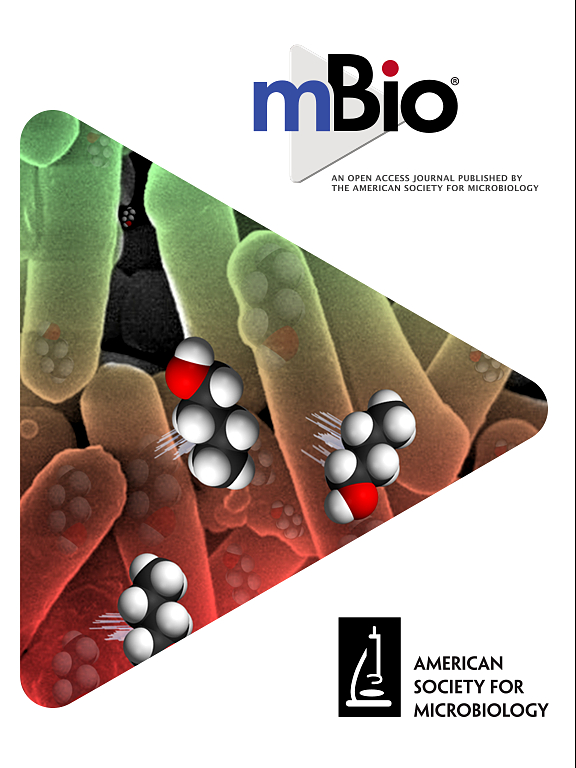E3泛素连接酶MARCH5通过催化k27连锁的病毒E蛋白多泛素化和抑制mavs介导的I型干扰素的产生,积极调节乙型脑炎病毒感染。
摘要
膜相关ring - ch型指状蛋白(MARCH)是一类E3泛素连接酶,已被报道参与多种病毒感染和I型干扰素(IFN)产生的调控。然而,MARCH蛋白影响日本脑炎病毒(JEV)感染的具体作用和机制仍然知之甚少。在这里,我们通过检测sirna介导的MARCH蛋白敲低对病毒感染的影响,系统地研究了MARCH蛋白在乙脑病毒复制中的功能相关性。我们发现MARCH5是乙脑病毒复制的正调节因子。敲除MARCH5显著降低病毒产量,而其过表达显著增强乙脑病毒复制。在机制上,MARCH5特异性地与乙脑病毒包膜(E)蛋白相互作用,并在赖氨酸(K)残基136和166处促进其k27连接的多泛素化。这种泛素化增强了病毒对允许细胞的附着。用精氨酸(R)取代赖氨酸残基可以减少乙脑病毒在体外的复制,并降低体内的病毒毒力。此外,JEV感染上调了MARCH5的表达。我们还发现,MARCH5通过泛素-蛋白酶体途径,通过催化其k48相关的泛素化,降解线粒体抗病毒信号蛋白(MAVS),从而抑制jev感染细胞中I型IFN的产生。这种I型干扰素的抑制进一步促进了乙脑病毒感染。总之,这些发现揭示了MARCH5在积极调节乙脑病毒感染中的新作用,揭示了MARCH5调节先天免疫应答的重要机制。乙脑病毒是亚洲许多国家病毒性脑炎的主要病因,估计有10万例临床人间病例,并给养猪业造成经济损失。到目前为止,还没有临床批准的抗病毒药物用于治疗乙脑病毒感染。尽管预防疫苗接种被广泛认为是预防日本脑炎(乙脑)最有效的策略,但乙脑病例的发病率仍在持续上升。因此,对病毒-宿主相互作用的深入了解将丰富我们对乙脑病毒感染机制的认识,并为开发下一代减毒活疫苗和抗病毒疗法确定新的靶点。据我们所知,这项研究首次确定了MARCH5是促进乙脑病毒感染的前病毒宿主因子。我们阐明了MARCH5促进乙脑病毒感染的两种不同机制。首先,MARCH5与病毒E蛋白相互作用,介导E蛋白K136和K166残基的k27连锁泛素化,促进病毒有效附着。此外,K136R-K166R的双突变在体外减轻了乙脑病毒感染,降低了小鼠的病毒毒力。其次,JEV感染诱导的MARCH5表达上调进一步抑制rig - i样受体(RLR)信号通路,有利于病毒感染。MARCH5通过在MAVS的K286位点偶联k48连接的多泛素来下调I型IFN的产生,从而通过泛素-蛋白酶体途径导致MAVS降解。总之,本研究对MARCH蛋白在乙脑病毒感染中的作用提供了新的见解,并确定了乙脑病毒E蛋白上特定的泛素化位点,这些泛素化位点可以作为病毒减弱和抗病毒治疗药物开发的靶点。Membrane-associated RING-CH-type finger (MARCH) proteins, a class of E3 ubiquitin ligases, have been reported to be involved in the infection of multiple viruses and the regulation of type I interferon (IFN) production. However, the specific role and mechanisms by which MARCH proteins influence Japanese encephalitis virus (JEV) infection remain poorly understood. Here, we systematically investigate the functional relevance of MARCH proteins in JEV replication by examining the effects of siRNA-mediated knockdown of MARCHs on viral infection. We identified MARCH5 as a positive regulator of JEV replication. The knockout of MARCH5 dramatically reduced viral yields, whereas its overexpression significantly enhanced JEV replication. Mechanistically, MARCH5 specifically interacts with the JEV envelope (E) protein and promotes its K27-linked polyubiquitination at the lysine (K) residues 136 and 166. This ubiquitination enhances viral attachment to permissive cells. Substituting these lysine residues with arginine (R) attenuated JEV replication in vitro and reduced viral virulence in vivo. Furthermore, JEV infection upregulated the expression of MARCH5. We also discovered that MARCH5 degrades mitochondrial antiviral-signaling protein (MAVS) through the ubiquitin-proteasome pathway by catalyzing its K48-linked ubiquitination, thereby inhibiting type I IFN production in JEV-infected cells. This suppression of type I IFN further facilitates JEV infection. In conclusion, these findings disclosed a novel role of MARCH5 in positively regulating JEV infection and revealed an important mechanism employed by MARCH5 to regulate the innate immune response.IMPORTANCEJEV is the leading cause of viral encephalitis in many countries of Asia with an estimated 100,000 clinical human cases and causes economic loss to the swine industry. Until now, there is no clinically approved antiviral for the treatment of JEV infection. Although vaccination prophylaxis is widely regarded as the most effective strategy for preventing Japanese encephalitis (JE), the incidence of JE cases continues to rise. Thus, a deeper understanding of virus-host interaction will enrich our knowledge of the mechanisms underlying JEV infection and identify novel targets for the development of next-generation live-attenuated vaccines and antiviral therapies. To the best of our knowledge, this study is the first to identify MARCH5 as a pro-viral host factor that facilitates JEV infection. We elucidated two distinct mechanisms by which MARCH5 promotes JEV infection. First, MARCH5 interacts with viral E protein and mediates the K27-linked ubiquitination of E protein at the K136 and K166 residues to facilitate efficient viral attachment. Furthermore, double mutations of K136R-K166R attenuated JEV infection in vitro and reduced viral virulence in mice. Second, the upregulated expression of MARCH5 induced by JEV infection further suppresses the RIG-I-like receptor (RLR) signaling pathway to benefit viral infection. MARCH5 downregulates type I IFN production by conjugating the K48-linked polyubiquitin at the K286 of MAVS, which leads to MAVS degradation through the ubiquitin-proteasome pathway. In summary, this study provides novel insights into the role played by MARCH proteins in JEV infection and identifies specific ubiquitination sites on JEV E protein that could be targeted for viral attenuation and the development of antiviral therapeutics.

 求助内容:
求助内容: 应助结果提醒方式:
应助结果提醒方式:


